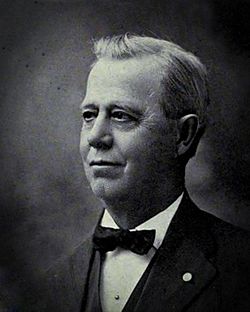Julius C. Moreland facts for kids
Quick facts for kids
Julius C. Moreland
|
|
|---|---|
 |
|
| Born | June 1, 1844 |
| Died | February 2, 1918 (aged 73) |
| Resting place | Lone Fir Cemetery |
| Alma mater | Portland Academy |
| Occupation | Caples and Moreland 1868 – 1874 Portland City Council 1872 – 1875 Portland City Attorney 1877 – 1881 Moreland and Masters 1886 – 1890 Multnomah County Judge 1890 – 1894 Oregon Supreme Court Clerk 1907 – 1918 |
| Years active | 1867 – 1918 |
| Political party | Republican |
| Spouse(s) | Abbie B. Kline |
| Children | Harvev, Susie (Gill), Eldon, Julius, Lueen (Moores) |
| Parent(s) | Jesse Moreland, Susan Robertson |
| Signature | |
Julius Caesar Moreland (born June 1, 1844, died February 2, 1918) was an important person in Oregon's history. He was a pioneer who traveled to Oregon, a successful lawyer, and a judge in Portland, Oregon. He also worked as the Clerk for the Oregon Supreme Court in Salem. Today, several neighborhoods in Portland, like Eastmoreland, Westmoreland, and Sellwood – Moreland, are named after him.
Early Life and Education
Julius Moreland was born in 1844 in Smith County, Tennessee. His parents were Jesse Moreland and Susan Robertson. Julius was the youngest of nine children. His father was a farmer and a Methodist preacher.
In 1848, when Julius was four years old, his family moved to Illinois. They farmed there for two years. Then, in 1852, the Moreland family joined a group of 20 wagons. They traveled west on the famous Oregon Trail. They arrived in the Oregon Territory in October 1852. By November, Julius's father had claimed 320 acres of land near the town of Needy.
Starting in 1860, Julius worked as a printer in Portland for a newspaper called the Oregon Farmer. This newspaper was the only farming newspaper in Oregon at the time. It closed in 1863. Julius graduated from the Portland Academy in 1865. After that, he studied law by working in the offices of former Portland Mayor David Logan. He began his law career in Eastern Oregon and the Idaho Territory. He also worked for a year at the Idaho Statesman newspaper. When he returned to Portland, he briefly worked at The Oregonian newspaper.
In 1867, Moreland married Abbie Kline in Boise, Idaho. Abbie was also a pioneer who had traveled from Kansas in 1853.
Career as a Lawyer and Judge
In 1868, Julius Moreland started a law firm called Caples and Moreland with attorney John F. Caples. This partnership lasted until 1874. Moreland was also active in local government. He served on the Portland City Council from 1872 to 1875. Later, he became the Portland City Attorney from 1877 to 1881.
In 1885, the governor of Oregon appointed Moreland as a judge for Multnomah County. He served for one year. After his term ended, he started another law firm called Moreland and Masters with William York Masters. This firm lasted until 1890. In 1890, Moreland was elected as a judge for the Multnomah County Court, serving for four years.
In 1907, Judge Moreland moved to Salem. He became the Clerk of the Oregon Supreme Court. He held this important position until he passed away suddenly in 1918.
Moreland Neighborhoods in Portland
Judge Moreland was an important leader in a company called the Portland Realty Company. This company planned to build homes on a large area of land called Crystal Springs Farm. The plan included four new neighborhoods: Westmoreland (created in 1909), Eastmoreland (created in 1910), Southmoreland, and Northmoreland. These neighborhoods were named after him.
Even though these areas were named after him, Judge Moreland was working in Salem at the time. So, he might have had only a small part in naming these neighborhoods. The Portland Realty Company was also not directly involved with the Ladd Estate Management Company, which owned the land. Ladd sold the land through another company.
After the Westmoreland and Eastmoreland neighborhoods were built, the area around SE Milwaukie Avenue and Bybee Boulevard became known as "Moreland." You can still see this name today in places like the Moreland Theater, the Moreland Presbyterian Church, and the Moreland Farmers Pantry. The name Sellwood – Moreland also developed over time to describe another part of the area, even though it wasn't part of the original plan.

